Principles of Business Communication: A Comprehensive Analysis Report
VerifiedAdded on 2020/07/23
|11
|3246
|35
Report
AI Summary
This report comprehensively examines the principles of business communication, encompassing negotiation strategies, presentation techniques, bespoke document creation, and information systems development. The report begins with an exploration of negotiation's significance in a business context, delving into various approaches and tactical components. It then transitions to presentation skills, detailing different presentation types, resource utilization, delivery methods, and best practices, including feedback collection. The report also discusses bespoke documents, covering their characteristics, creation processes, legal requirements, and approval procedures. Finally, it addresses information system development, outlining its stages, benefits, limitations, and legal, security, and confidentiality considerations, as well as monitoring effectiveness. The report provides a thorough overview of essential business communication concepts, offering valuable insights for effective communication practices.
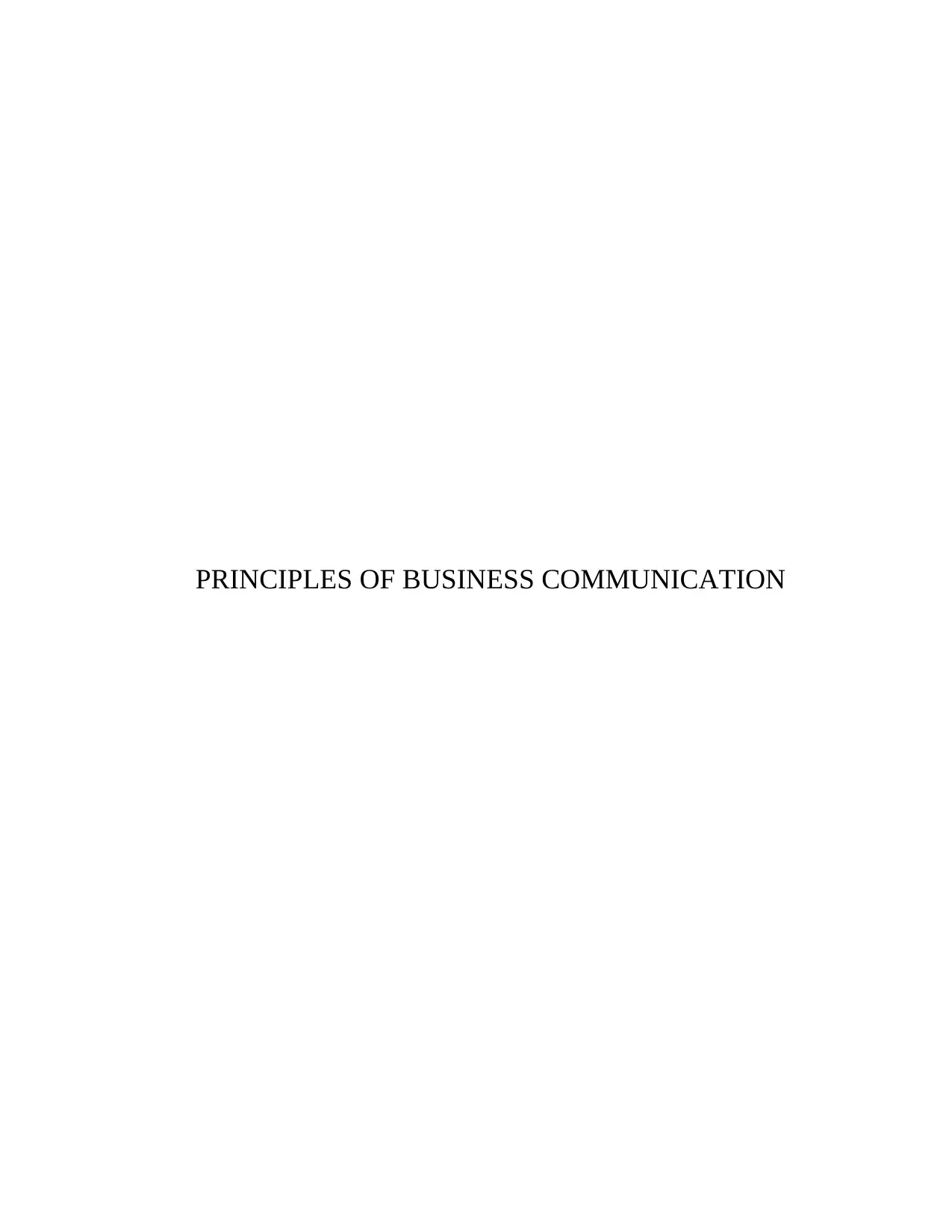
PRINCIPLES OF BUSINESS COMMUNICATION
Paraphrase This Document
Need a fresh take? Get an instant paraphrase of this document with our AI Paraphraser
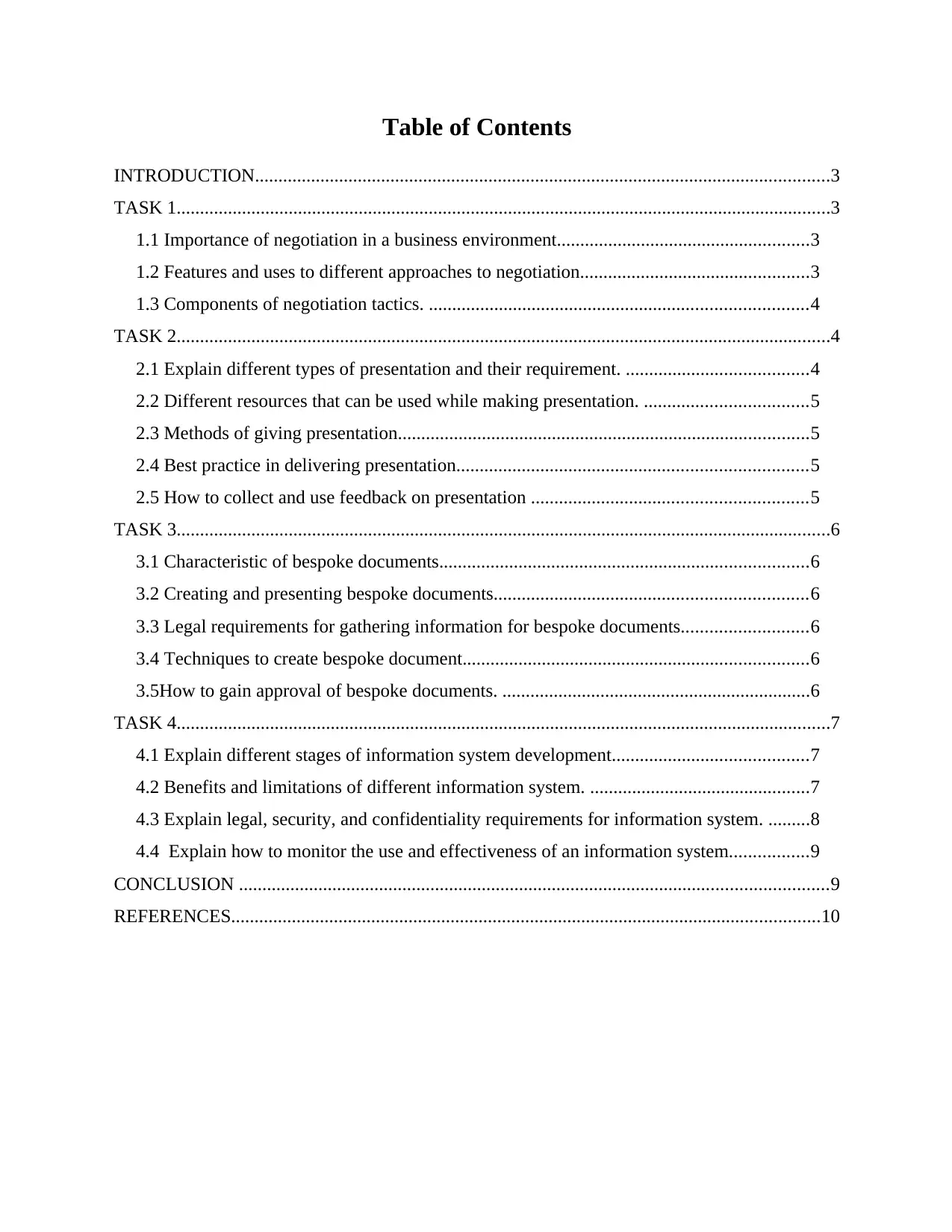
Table of Contents
INTRODUCTION...........................................................................................................................3
TASK 1............................................................................................................................................3
1.1 Importance of negotiation in a business environment......................................................3
1.2 Features and uses to different approaches to negotiation.................................................3
1.3 Components of negotiation tactics. .................................................................................4
TASK 2............................................................................................................................................4
2.1 Explain different types of presentation and their requirement. .......................................4
2.2 Different resources that can be used while making presentation. ...................................5
2.3 Methods of giving presentation........................................................................................5
2.4 Best practice in delivering presentation...........................................................................5
2.5 How to collect and use feedback on presentation ...........................................................5
TASK 3............................................................................................................................................6
3.1 Characteristic of bespoke documents...............................................................................6
3.2 Creating and presenting bespoke documents...................................................................6
3.3 Legal requirements for gathering information for bespoke documents...........................6
3.4 Techniques to create bespoke document..........................................................................6
3.5How to gain approval of bespoke documents. ..................................................................6
TASK 4............................................................................................................................................7
4.1 Explain different stages of information system development..........................................7
4.2 Benefits and limitations of different information system. ...............................................7
4.3 Explain legal, security, and confidentiality requirements for information system. .........8
4.4 Explain how to monitor the use and effectiveness of an information system.................9
CONCLUSION ..............................................................................................................................9
REFERENCES..............................................................................................................................10
INTRODUCTION...........................................................................................................................3
TASK 1............................................................................................................................................3
1.1 Importance of negotiation in a business environment......................................................3
1.2 Features and uses to different approaches to negotiation.................................................3
1.3 Components of negotiation tactics. .................................................................................4
TASK 2............................................................................................................................................4
2.1 Explain different types of presentation and their requirement. .......................................4
2.2 Different resources that can be used while making presentation. ...................................5
2.3 Methods of giving presentation........................................................................................5
2.4 Best practice in delivering presentation...........................................................................5
2.5 How to collect and use feedback on presentation ...........................................................5
TASK 3............................................................................................................................................6
3.1 Characteristic of bespoke documents...............................................................................6
3.2 Creating and presenting bespoke documents...................................................................6
3.3 Legal requirements for gathering information for bespoke documents...........................6
3.4 Techniques to create bespoke document..........................................................................6
3.5How to gain approval of bespoke documents. ..................................................................6
TASK 4............................................................................................................................................7
4.1 Explain different stages of information system development..........................................7
4.2 Benefits and limitations of different information system. ...............................................7
4.3 Explain legal, security, and confidentiality requirements for information system. .........8
4.4 Explain how to monitor the use and effectiveness of an information system.................9
CONCLUSION ..............................................................................................................................9
REFERENCES..............................................................................................................................10
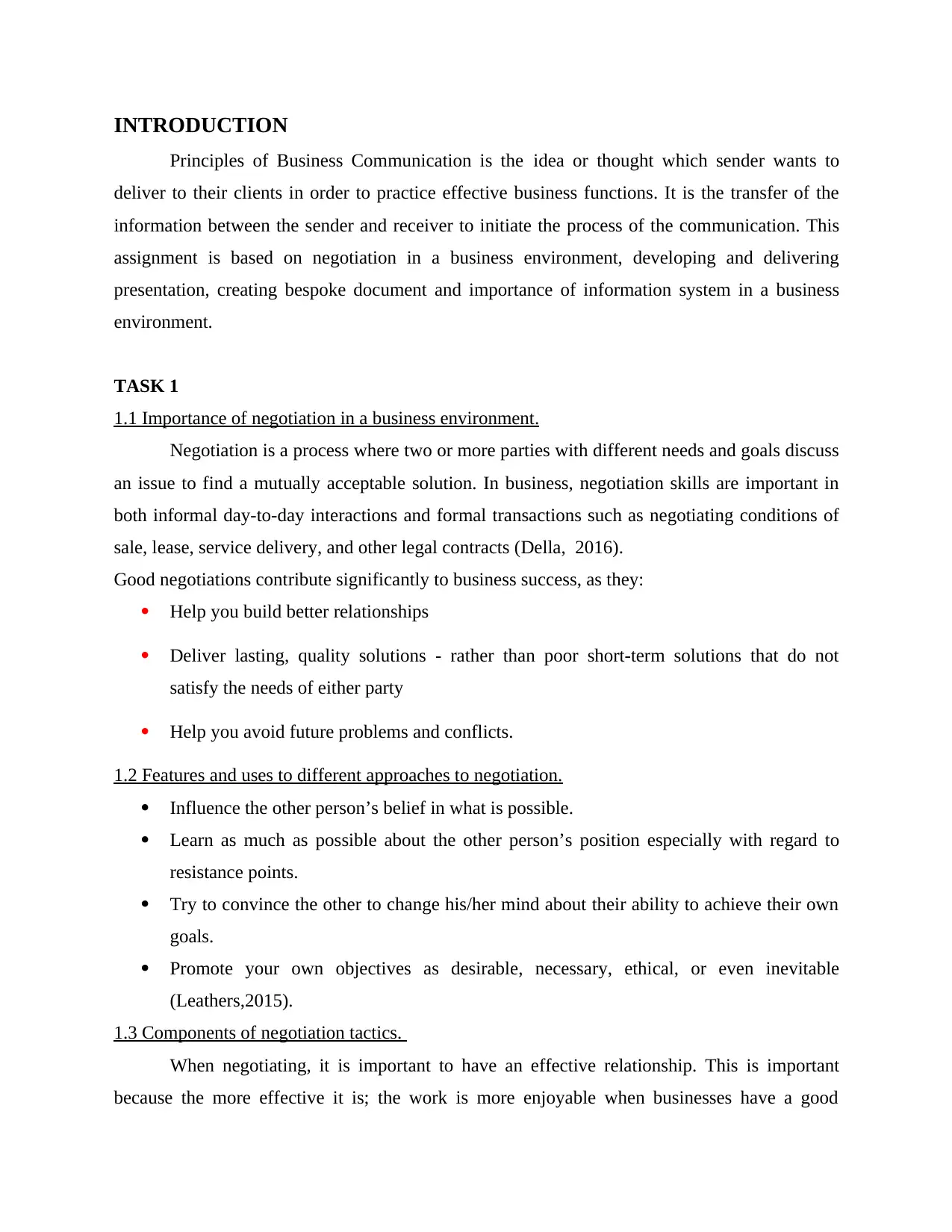
INTRODUCTION
Principles of Business Communication is the idea or thought which sender wants to
deliver to their clients in order to practice effective business functions. It is the transfer of the
information between the sender and receiver to initiate the process of the communication. This
assignment is based on negotiation in a business environment, developing and delivering
presentation, creating bespoke document and importance of information system in a business
environment.
TASK 1
1.1 Importance of negotiation in a business environment.
Negotiation is a process where two or more parties with different needs and goals discuss
an issue to find a mutually acceptable solution. In business, negotiation skills are important in
both informal day-to-day interactions and formal transactions such as negotiating conditions of
sale, lease, service delivery, and other legal contracts (Della, 2016).
Good negotiations contribute significantly to business success, as they:
Help you build better relationships
Deliver lasting, quality solutions - rather than poor short-term solutions that do not
satisfy the needs of either party
Help you avoid future problems and conflicts.
1.2 Features and uses to different approaches to negotiation.
Influence the other person’s belief in what is possible.
Learn as much as possible about the other person’s position especially with regard to
resistance points.
Try to convince the other to change his/her mind about their ability to achieve their own
goals.
Promote your own objectives as desirable, necessary, ethical, or even inevitable
(Leathers,2015).
1.3 Components of negotiation tactics.
When negotiating, it is important to have an effective relationship. This is important
because the more effective it is; the work is more enjoyable when businesses have a good
Principles of Business Communication is the idea or thought which sender wants to
deliver to their clients in order to practice effective business functions. It is the transfer of the
information between the sender and receiver to initiate the process of the communication. This
assignment is based on negotiation in a business environment, developing and delivering
presentation, creating bespoke document and importance of information system in a business
environment.
TASK 1
1.1 Importance of negotiation in a business environment.
Negotiation is a process where two or more parties with different needs and goals discuss
an issue to find a mutually acceptable solution. In business, negotiation skills are important in
both informal day-to-day interactions and formal transactions such as negotiating conditions of
sale, lease, service delivery, and other legal contracts (Della, 2016).
Good negotiations contribute significantly to business success, as they:
Help you build better relationships
Deliver lasting, quality solutions - rather than poor short-term solutions that do not
satisfy the needs of either party
Help you avoid future problems and conflicts.
1.2 Features and uses to different approaches to negotiation.
Influence the other person’s belief in what is possible.
Learn as much as possible about the other person’s position especially with regard to
resistance points.
Try to convince the other to change his/her mind about their ability to achieve their own
goals.
Promote your own objectives as desirable, necessary, ethical, or even inevitable
(Leathers,2015).
1.3 Components of negotiation tactics.
When negotiating, it is important to have an effective relationship. This is important
because the more effective it is; the work is more enjoyable when businesses have a good
⊘ This is a preview!⊘
Do you want full access?
Subscribe today to unlock all pages.

Trusted by 1+ million students worldwide
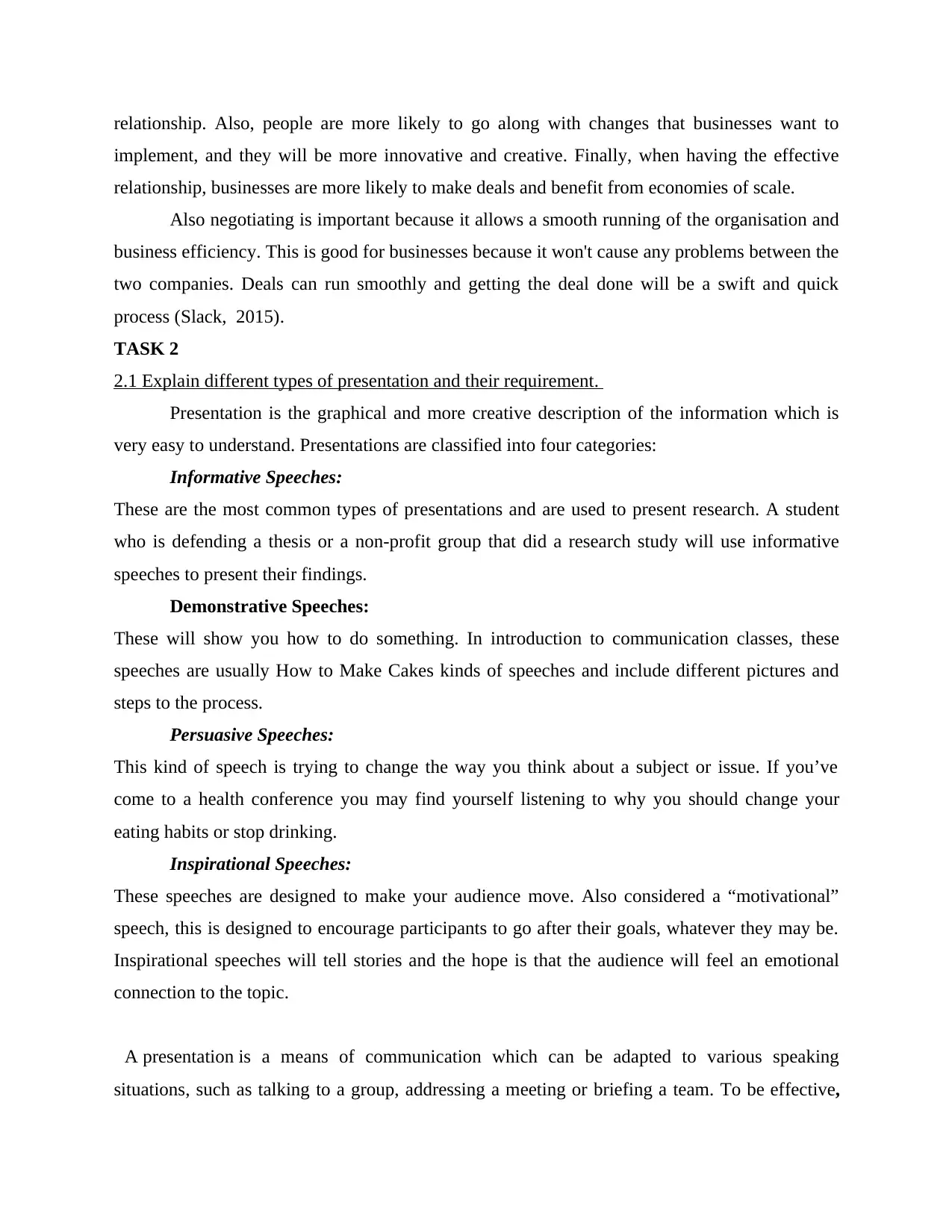
relationship. Also, people are more likely to go along with changes that businesses want to
implement, and they will be more innovative and creative. Finally, when having the effective
relationship, businesses are more likely to make deals and benefit from economies of scale.
Also negotiating is important because it allows a smooth running of the organisation and
business efficiency. This is good for businesses because it won't cause any problems between the
two companies. Deals can run smoothly and getting the deal done will be a swift and quick
process (Slack, 2015).
TASK 2
2.1 Explain different types of presentation and their requirement.
Presentation is the graphical and more creative description of the information which is
very easy to understand. Presentations are classified into four categories:
Informative Speeches:
These are the most common types of presentations and are used to present research. A student
who is defending a thesis or a non-profit group that did a research study will use informative
speeches to present their findings.
Demonstrative Speeches:
These will show you how to do something. In introduction to communication classes, these
speeches are usually How to Make Cakes kinds of speeches and include different pictures and
steps to the process.
Persuasive Speeches:
This kind of speech is trying to change the way you think about a subject or issue. If you’ve
come to a health conference you may find yourself listening to why you should change your
eating habits or stop drinking.
Inspirational Speeches:
These speeches are designed to make your audience move. Also considered a “motivational”
speech, this is designed to encourage participants to go after their goals, whatever they may be.
Inspirational speeches will tell stories and the hope is that the audience will feel an emotional
connection to the topic.
A presentation is a means of communication which can be adapted to various speaking
situations, such as talking to a group, addressing a meeting or briefing a team. To be effective,
implement, and they will be more innovative and creative. Finally, when having the effective
relationship, businesses are more likely to make deals and benefit from economies of scale.
Also negotiating is important because it allows a smooth running of the organisation and
business efficiency. This is good for businesses because it won't cause any problems between the
two companies. Deals can run smoothly and getting the deal done will be a swift and quick
process (Slack, 2015).
TASK 2
2.1 Explain different types of presentation and their requirement.
Presentation is the graphical and more creative description of the information which is
very easy to understand. Presentations are classified into four categories:
Informative Speeches:
These are the most common types of presentations and are used to present research. A student
who is defending a thesis or a non-profit group that did a research study will use informative
speeches to present their findings.
Demonstrative Speeches:
These will show you how to do something. In introduction to communication classes, these
speeches are usually How to Make Cakes kinds of speeches and include different pictures and
steps to the process.
Persuasive Speeches:
This kind of speech is trying to change the way you think about a subject or issue. If you’ve
come to a health conference you may find yourself listening to why you should change your
eating habits or stop drinking.
Inspirational Speeches:
These speeches are designed to make your audience move. Also considered a “motivational”
speech, this is designed to encourage participants to go after their goals, whatever they may be.
Inspirational speeches will tell stories and the hope is that the audience will feel an emotional
connection to the topic.
A presentation is a means of communication which can be adapted to various speaking
situations, such as talking to a group, addressing a meeting or briefing a team. To be effective,
Paraphrase This Document
Need a fresh take? Get an instant paraphrase of this document with our AI Paraphraser
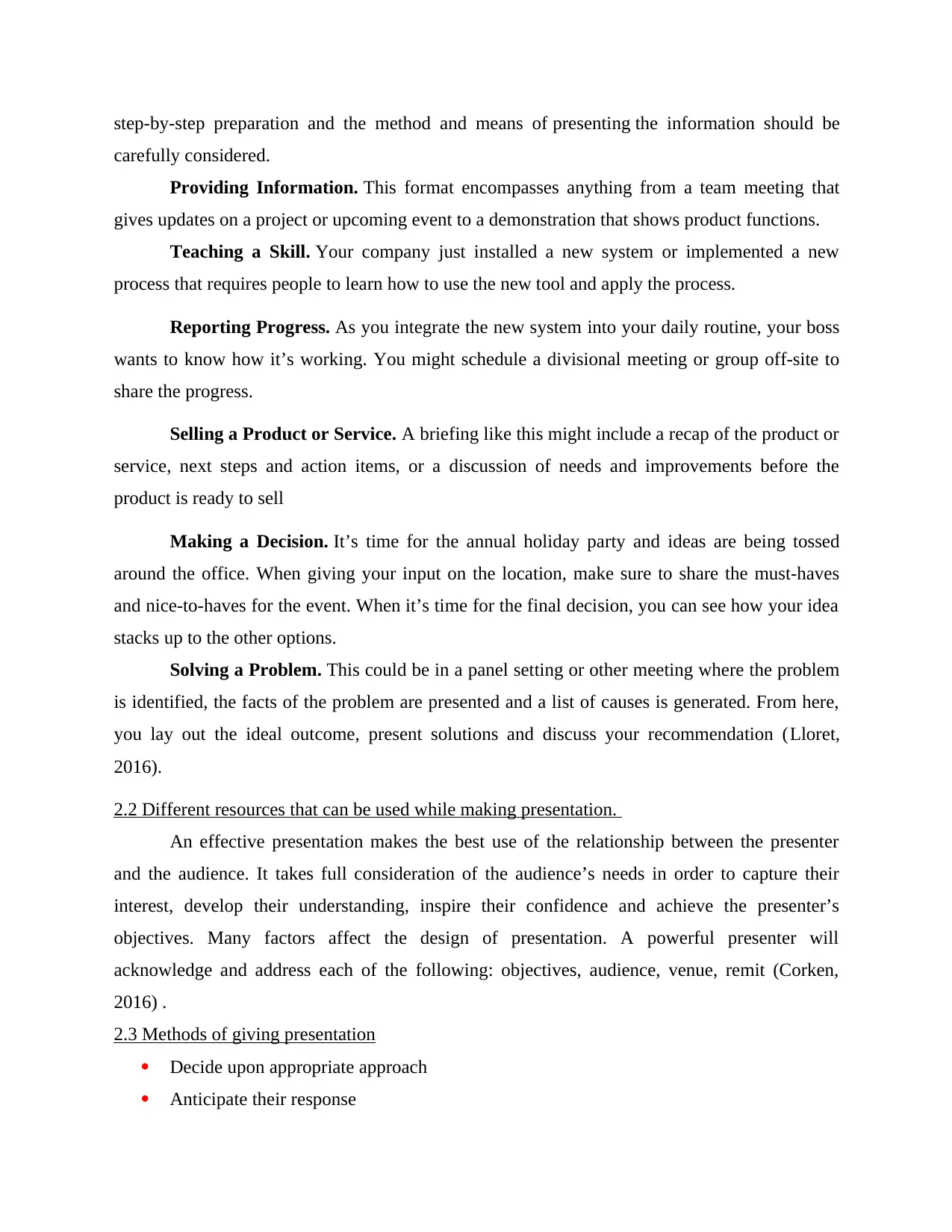
step-by-step preparation and the method and means of presenting the information should be
carefully considered.
Providing Information. This format encompasses anything from a team meeting that
gives updates on a project or upcoming event to a demonstration that shows product functions.
Teaching a Skill. Your company just installed a new system or implemented a new
process that requires people to learn how to use the new tool and apply the process.
Reporting Progress. As you integrate the new system into your daily routine, your boss
wants to know how it’s working. You might schedule a divisional meeting or group off-site to
share the progress.
Selling a Product or Service. A briefing like this might include a recap of the product or
service, next steps and action items, or a discussion of needs and improvements before the
product is ready to sell
Making a Decision. It’s time for the annual holiday party and ideas are being tossed
around the office. When giving your input on the location, make sure to share the must-haves
and nice-to-haves for the event. When it’s time for the final decision, you can see how your idea
stacks up to the other options.
Solving a Problem. This could be in a panel setting or other meeting where the problem
is identified, the facts of the problem are presented and a list of causes is generated. From here,
you lay out the ideal outcome, present solutions and discuss your recommendation (Lloret,
2016).
2.2 Different resources that can be used while making presentation.
An effective presentation makes the best use of the relationship between the presenter
and the audience. It takes full consideration of the audience’s needs in order to capture their
interest, develop their understanding, inspire their confidence and achieve the presenter’s
objectives. Many factors affect the design of presentation. A powerful presenter will
acknowledge and address each of the following: objectives, audience, venue, remit (Corken,
2016) .
2.3 Methods of giving presentation
Decide upon appropriate approach
Anticipate their response
carefully considered.
Providing Information. This format encompasses anything from a team meeting that
gives updates on a project or upcoming event to a demonstration that shows product functions.
Teaching a Skill. Your company just installed a new system or implemented a new
process that requires people to learn how to use the new tool and apply the process.
Reporting Progress. As you integrate the new system into your daily routine, your boss
wants to know how it’s working. You might schedule a divisional meeting or group off-site to
share the progress.
Selling a Product or Service. A briefing like this might include a recap of the product or
service, next steps and action items, or a discussion of needs and improvements before the
product is ready to sell
Making a Decision. It’s time for the annual holiday party and ideas are being tossed
around the office. When giving your input on the location, make sure to share the must-haves
and nice-to-haves for the event. When it’s time for the final decision, you can see how your idea
stacks up to the other options.
Solving a Problem. This could be in a panel setting or other meeting where the problem
is identified, the facts of the problem are presented and a list of causes is generated. From here,
you lay out the ideal outcome, present solutions and discuss your recommendation (Lloret,
2016).
2.2 Different resources that can be used while making presentation.
An effective presentation makes the best use of the relationship between the presenter
and the audience. It takes full consideration of the audience’s needs in order to capture their
interest, develop their understanding, inspire their confidence and achieve the presenter’s
objectives. Many factors affect the design of presentation. A powerful presenter will
acknowledge and address each of the following: objectives, audience, venue, remit (Corken,
2016) .
2.3 Methods of giving presentation
Decide upon appropriate approach
Anticipate their response
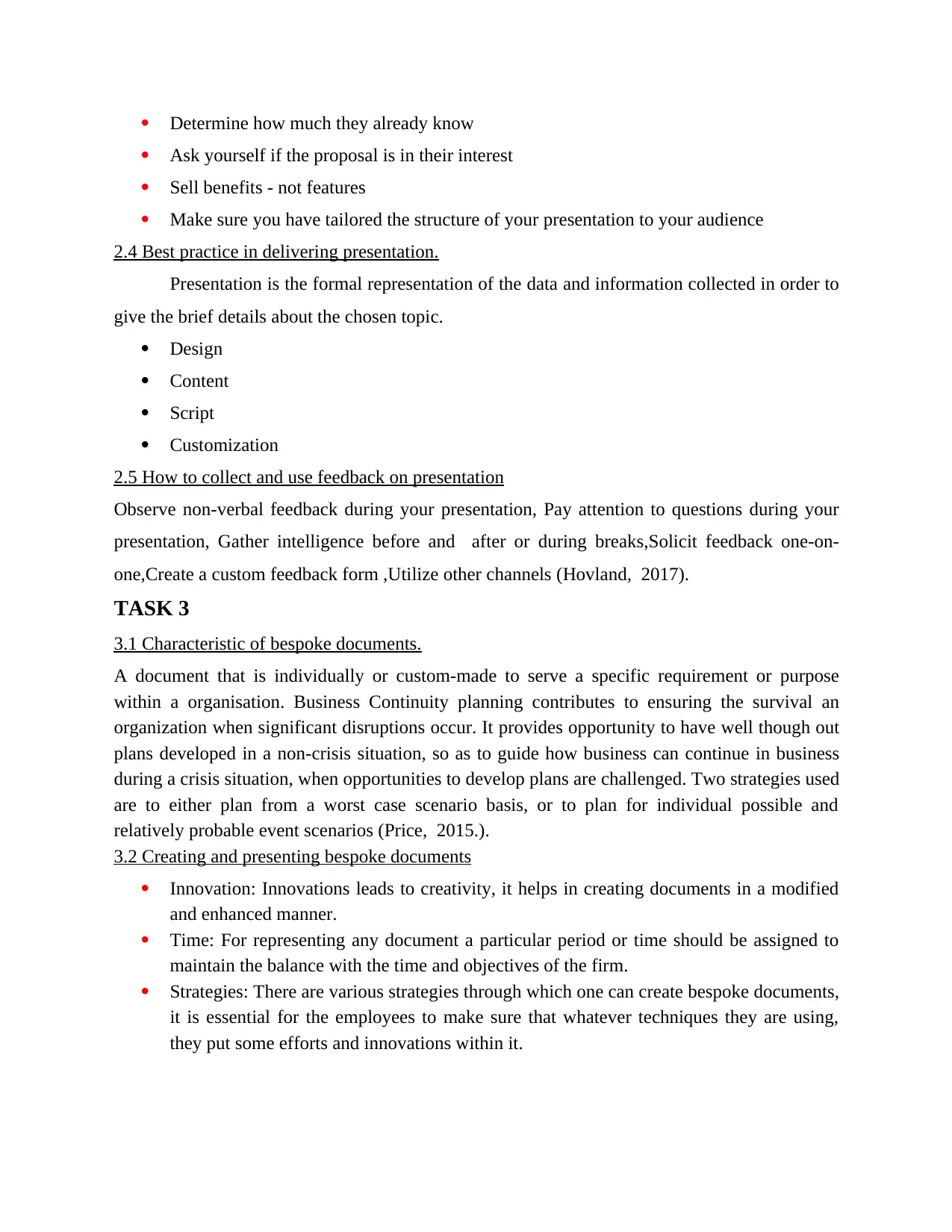
Determine how much they already know
Ask yourself if the proposal is in their interest
Sell benefits - not features
Make sure you have tailored the structure of your presentation to your audience
2.4 Best practice in delivering presentation.
Presentation is the formal representation of the data and information collected in order to
give the brief details about the chosen topic.
Design
Content
Script
Customization
2.5 How to collect and use feedback on presentation
Observe non-verbal feedback during your presentation, Pay attention to questions during your
presentation, Gather intelligence before and after or during breaks,Solicit feedback one-on-
one,Create a custom feedback form ,Utilize other channels (Hovland, 2017).
TASK 3
3.1 Characteristic of bespoke documents.
A document that is individually or custom-made to serve a specific requirement or purpose
within a organisation. Business Continuity planning contributes to ensuring the survival an
organization when significant disruptions occur. It provides opportunity to have well though out
plans developed in a non-crisis situation, so as to guide how business can continue in business
during a crisis situation, when opportunities to develop plans are challenged. Two strategies used
are to either plan from a worst case scenario basis, or to plan for individual possible and
relatively probable event scenarios (Price, 2015.).
3.2 Creating and presenting bespoke documents
Innovation: Innovations leads to creativity, it helps in creating documents in a modified
and enhanced manner.
Time: For representing any document a particular period or time should be assigned to
maintain the balance with the time and objectives of the firm.
Strategies: There are various strategies through which one can create bespoke documents,
it is essential for the employees to make sure that whatever techniques they are using,
they put some efforts and innovations within it.
Ask yourself if the proposal is in their interest
Sell benefits - not features
Make sure you have tailored the structure of your presentation to your audience
2.4 Best practice in delivering presentation.
Presentation is the formal representation of the data and information collected in order to
give the brief details about the chosen topic.
Design
Content
Script
Customization
2.5 How to collect and use feedback on presentation
Observe non-verbal feedback during your presentation, Pay attention to questions during your
presentation, Gather intelligence before and after or during breaks,Solicit feedback one-on-
one,Create a custom feedback form ,Utilize other channels (Hovland, 2017).
TASK 3
3.1 Characteristic of bespoke documents.
A document that is individually or custom-made to serve a specific requirement or purpose
within a organisation. Business Continuity planning contributes to ensuring the survival an
organization when significant disruptions occur. It provides opportunity to have well though out
plans developed in a non-crisis situation, so as to guide how business can continue in business
during a crisis situation, when opportunities to develop plans are challenged. Two strategies used
are to either plan from a worst case scenario basis, or to plan for individual possible and
relatively probable event scenarios (Price, 2015.).
3.2 Creating and presenting bespoke documents
Innovation: Innovations leads to creativity, it helps in creating documents in a modified
and enhanced manner.
Time: For representing any document a particular period or time should be assigned to
maintain the balance with the time and objectives of the firm.
Strategies: There are various strategies through which one can create bespoke documents,
it is essential for the employees to make sure that whatever techniques they are using,
they put some efforts and innovations within it.
⊘ This is a preview!⊘
Do you want full access?
Subscribe today to unlock all pages.

Trusted by 1+ million students worldwide
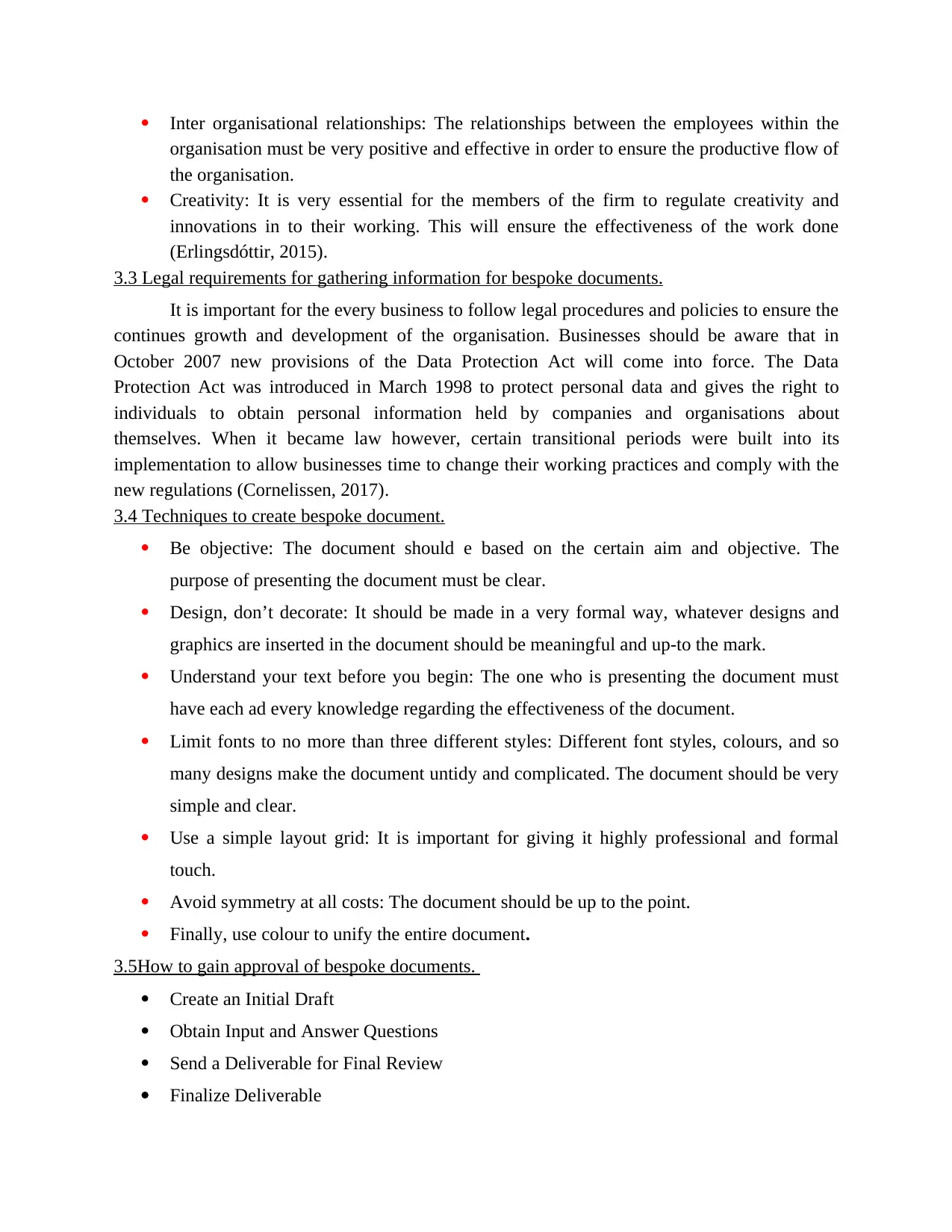
Inter organisational relationships: The relationships between the employees within the
organisation must be very positive and effective in order to ensure the productive flow of
the organisation.
Creativity: It is very essential for the members of the firm to regulate creativity and
innovations in to their working. This will ensure the effectiveness of the work done
(Erlingsdóttir, 2015).
3.3 Legal requirements for gathering information for bespoke documents.
It is important for the every business to follow legal procedures and policies to ensure the
continues growth and development of the organisation. Businesses should be aware that in
October 2007 new provisions of the Data Protection Act will come into force. The Data
Protection Act was introduced in March 1998 to protect personal data and gives the right to
individuals to obtain personal information held by companies and organisations about
themselves. When it became law however, certain transitional periods were built into its
implementation to allow businesses time to change their working practices and comply with the
new regulations (Cornelissen, 2017).
3.4 Techniques to create bespoke document.
Be objective: The document should e based on the certain aim and objective. The
purpose of presenting the document must be clear.
Design, don’t decorate: It should be made in a very formal way, whatever designs and
graphics are inserted in the document should be meaningful and up-to the mark.
Understand your text before you begin: The one who is presenting the document must
have each ad every knowledge regarding the effectiveness of the document.
Limit fonts to no more than three different styles: Different font styles, colours, and so
many designs make the document untidy and complicated. The document should be very
simple and clear.
Use a simple layout grid: It is important for giving it highly professional and formal
touch.
Avoid symmetry at all costs: The document should be up to the point.
Finally, use colour to unify the entire document.
3.5How to gain approval of bespoke documents.
Create an Initial Draft
Obtain Input and Answer Questions
Send a Deliverable for Final Review
Finalize Deliverable
organisation must be very positive and effective in order to ensure the productive flow of
the organisation.
Creativity: It is very essential for the members of the firm to regulate creativity and
innovations in to their working. This will ensure the effectiveness of the work done
(Erlingsdóttir, 2015).
3.3 Legal requirements for gathering information for bespoke documents.
It is important for the every business to follow legal procedures and policies to ensure the
continues growth and development of the organisation. Businesses should be aware that in
October 2007 new provisions of the Data Protection Act will come into force. The Data
Protection Act was introduced in March 1998 to protect personal data and gives the right to
individuals to obtain personal information held by companies and organisations about
themselves. When it became law however, certain transitional periods were built into its
implementation to allow businesses time to change their working practices and comply with the
new regulations (Cornelissen, 2017).
3.4 Techniques to create bespoke document.
Be objective: The document should e based on the certain aim and objective. The
purpose of presenting the document must be clear.
Design, don’t decorate: It should be made in a very formal way, whatever designs and
graphics are inserted in the document should be meaningful and up-to the mark.
Understand your text before you begin: The one who is presenting the document must
have each ad every knowledge regarding the effectiveness of the document.
Limit fonts to no more than three different styles: Different font styles, colours, and so
many designs make the document untidy and complicated. The document should be very
simple and clear.
Use a simple layout grid: It is important for giving it highly professional and formal
touch.
Avoid symmetry at all costs: The document should be up to the point.
Finally, use colour to unify the entire document.
3.5How to gain approval of bespoke documents.
Create an Initial Draft
Obtain Input and Answer Questions
Send a Deliverable for Final Review
Finalize Deliverable
Paraphrase This Document
Need a fresh take? Get an instant paraphrase of this document with our AI Paraphraser
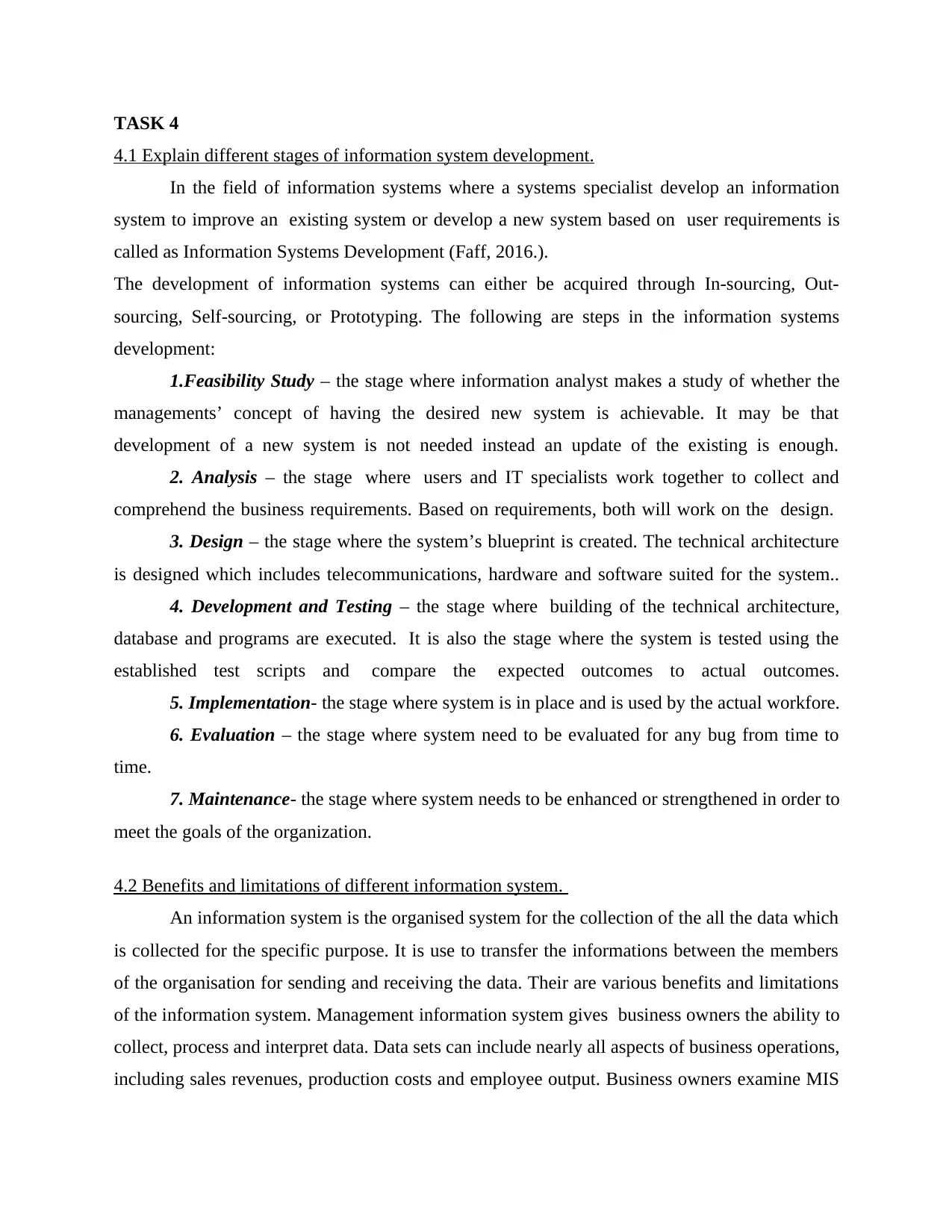
TASK 4
4.1 Explain different stages of information system development.
In the field of information systems where a systems specialist develop an information
system to improve an existing system or develop a new system based on user requirements is
called as Information Systems Development (Faff, 2016.).
The development of information systems can either be acquired through In-sourcing, Out-
sourcing, Self-sourcing, or Prototyping. The following are steps in the information systems
development:
1.Feasibility Study – the stage where information analyst makes a study of whether the
managements’ concept of having the desired new system is achievable. It may be that
development of a new system is not needed instead an update of the existing is enough.
2. Analysis – the stage where users and IT specialists work together to collect and
comprehend the business requirements. Based on requirements, both will work on the design.
3. Design – the stage where the system’s blueprint is created. The technical architecture
is designed which includes telecommunications, hardware and software suited for the system..
4. Development and Testing – the stage where building of the technical architecture,
database and programs are executed. It is also the stage where the system is tested using the
established test scripts and compare the expected outcomes to actual outcomes.
5. Implementation- the stage where system is in place and is used by the actual workfore.
6. Evaluation – the stage where system need to be evaluated for any bug from time to
time.
7. Maintenance- the stage where system needs to be enhanced or strengthened in order to
meet the goals of the organization.
4.2 Benefits and limitations of different information system.
An information system is the organised system for the collection of the all the data which
is collected for the specific purpose. It is use to transfer the informations between the members
of the organisation for sending and receiving the data. Their are various benefits and limitations
of the information system. Management information system gives business owners the ability to
collect, process and interpret data. Data sets can include nearly all aspects of business operations,
including sales revenues, production costs and employee output. Business owners examine MIS
4.1 Explain different stages of information system development.
In the field of information systems where a systems specialist develop an information
system to improve an existing system or develop a new system based on user requirements is
called as Information Systems Development (Faff, 2016.).
The development of information systems can either be acquired through In-sourcing, Out-
sourcing, Self-sourcing, or Prototyping. The following are steps in the information systems
development:
1.Feasibility Study – the stage where information analyst makes a study of whether the
managements’ concept of having the desired new system is achievable. It may be that
development of a new system is not needed instead an update of the existing is enough.
2. Analysis – the stage where users and IT specialists work together to collect and
comprehend the business requirements. Based on requirements, both will work on the design.
3. Design – the stage where the system’s blueprint is created. The technical architecture
is designed which includes telecommunications, hardware and software suited for the system..
4. Development and Testing – the stage where building of the technical architecture,
database and programs are executed. It is also the stage where the system is tested using the
established test scripts and compare the expected outcomes to actual outcomes.
5. Implementation- the stage where system is in place and is used by the actual workfore.
6. Evaluation – the stage where system need to be evaluated for any bug from time to
time.
7. Maintenance- the stage where system needs to be enhanced or strengthened in order to
meet the goals of the organization.
4.2 Benefits and limitations of different information system.
An information system is the organised system for the collection of the all the data which
is collected for the specific purpose. It is use to transfer the informations between the members
of the organisation for sending and receiving the data. Their are various benefits and limitations
of the information system. Management information system gives business owners the ability to
collect, process and interpret data. Data sets can include nearly all aspects of business operations,
including sales revenues, production costs and employee output. Business owners examine MIS
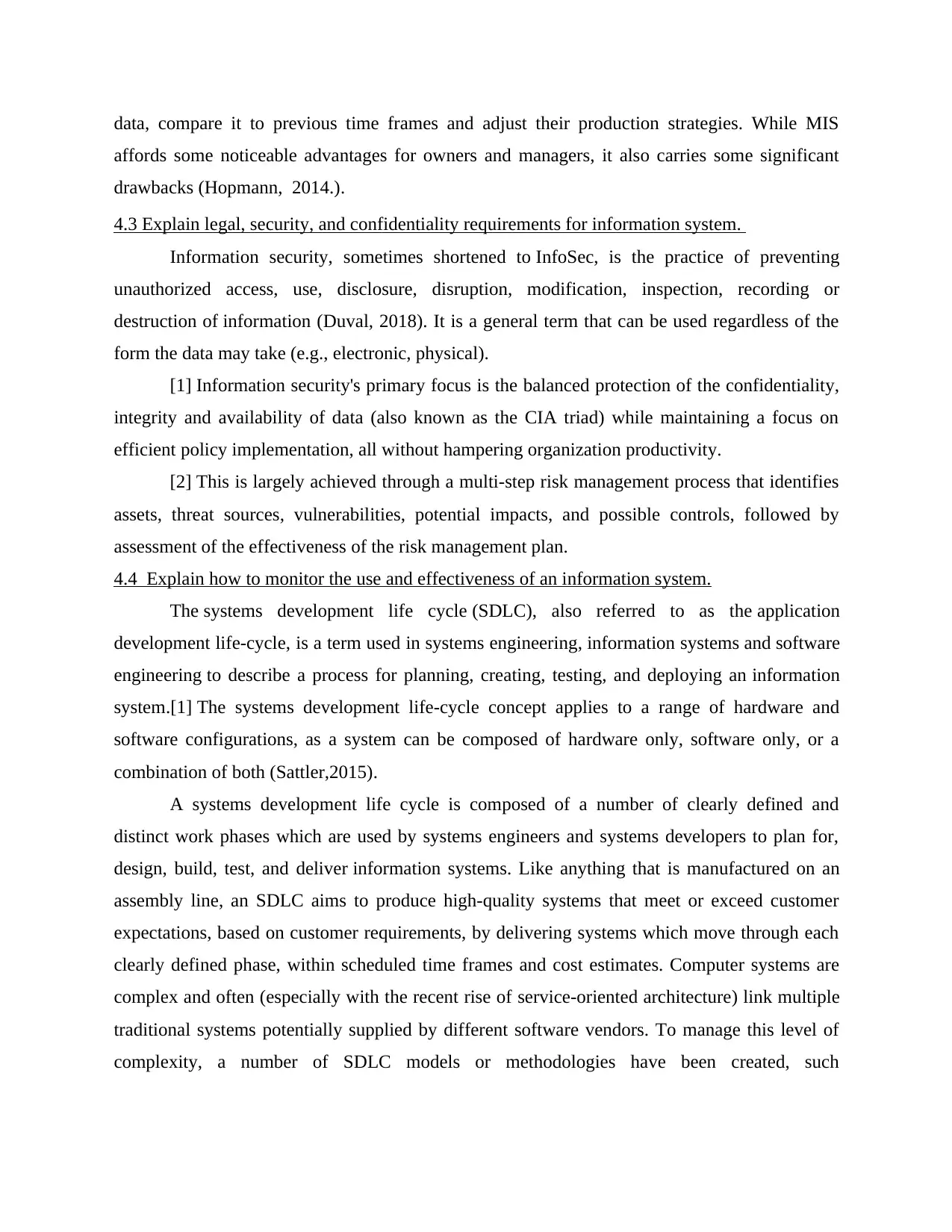
data, compare it to previous time frames and adjust their production strategies. While MIS
affords some noticeable advantages for owners and managers, it also carries some significant
drawbacks (Hopmann, 2014.).
4.3 Explain legal, security, and confidentiality requirements for information system.
Information security, sometimes shortened to InfoSec, is the practice of preventing
unauthorized access, use, disclosure, disruption, modification, inspection, recording or
destruction of information (Duval, 2018). It is a general term that can be used regardless of the
form the data may take (e.g., electronic, physical).
[1] Information security's primary focus is the balanced protection of the confidentiality,
integrity and availability of data (also known as the CIA triad) while maintaining a focus on
efficient policy implementation, all without hampering organization productivity.
[2] This is largely achieved through a multi-step risk management process that identifies
assets, threat sources, vulnerabilities, potential impacts, and possible controls, followed by
assessment of the effectiveness of the risk management plan.
4.4 Explain how to monitor the use and effectiveness of an information system.
The systems development life cycle (SDLC), also referred to as the application
development life-cycle, is a term used in systems engineering, information systems and software
engineering to describe a process for planning, creating, testing, and deploying an information
system.[1] The systems development life-cycle concept applies to a range of hardware and
software configurations, as a system can be composed of hardware only, software only, or a
combination of both (Sattler,2015).
A systems development life cycle is composed of a number of clearly defined and
distinct work phases which are used by systems engineers and systems developers to plan for,
design, build, test, and deliver information systems. Like anything that is manufactured on an
assembly line, an SDLC aims to produce high-quality systems that meet or exceed customer
expectations, based on customer requirements, by delivering systems which move through each
clearly defined phase, within scheduled time frames and cost estimates. Computer systems are
complex and often (especially with the recent rise of service-oriented architecture) link multiple
traditional systems potentially supplied by different software vendors. To manage this level of
complexity, a number of SDLC models or methodologies have been created, such
affords some noticeable advantages for owners and managers, it also carries some significant
drawbacks (Hopmann, 2014.).
4.3 Explain legal, security, and confidentiality requirements for information system.
Information security, sometimes shortened to InfoSec, is the practice of preventing
unauthorized access, use, disclosure, disruption, modification, inspection, recording or
destruction of information (Duval, 2018). It is a general term that can be used regardless of the
form the data may take (e.g., electronic, physical).
[1] Information security's primary focus is the balanced protection of the confidentiality,
integrity and availability of data (also known as the CIA triad) while maintaining a focus on
efficient policy implementation, all without hampering organization productivity.
[2] This is largely achieved through a multi-step risk management process that identifies
assets, threat sources, vulnerabilities, potential impacts, and possible controls, followed by
assessment of the effectiveness of the risk management plan.
4.4 Explain how to monitor the use and effectiveness of an information system.
The systems development life cycle (SDLC), also referred to as the application
development life-cycle, is a term used in systems engineering, information systems and software
engineering to describe a process for planning, creating, testing, and deploying an information
system.[1] The systems development life-cycle concept applies to a range of hardware and
software configurations, as a system can be composed of hardware only, software only, or a
combination of both (Sattler,2015).
A systems development life cycle is composed of a number of clearly defined and
distinct work phases which are used by systems engineers and systems developers to plan for,
design, build, test, and deliver information systems. Like anything that is manufactured on an
assembly line, an SDLC aims to produce high-quality systems that meet or exceed customer
expectations, based on customer requirements, by delivering systems which move through each
clearly defined phase, within scheduled time frames and cost estimates. Computer systems are
complex and often (especially with the recent rise of service-oriented architecture) link multiple
traditional systems potentially supplied by different software vendors. To manage this level of
complexity, a number of SDLC models or methodologies have been created, such
⊘ This is a preview!⊘
Do you want full access?
Subscribe today to unlock all pages.

Trusted by 1+ million students worldwide
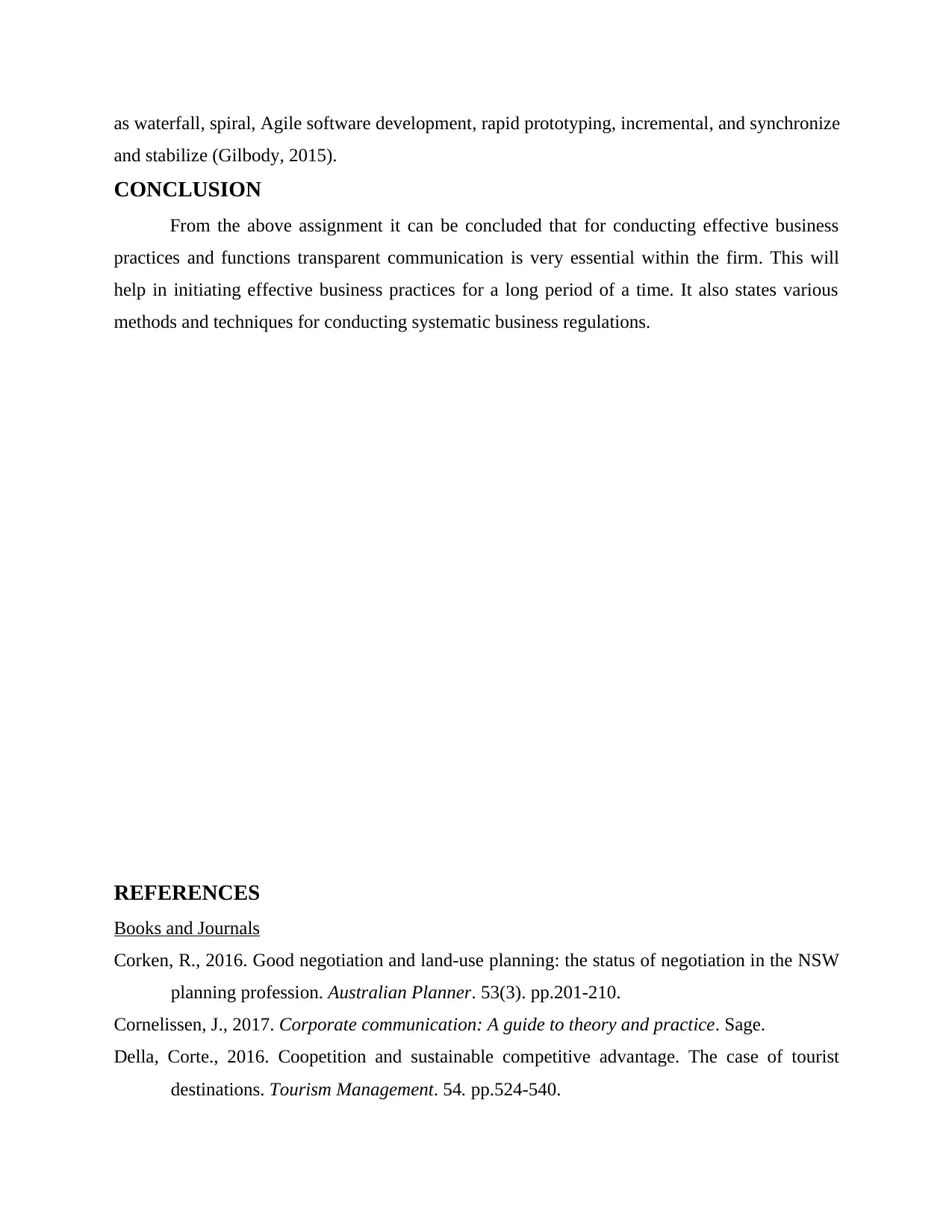
as waterfall, spiral, Agile software development, rapid prototyping, incremental, and synchronize
and stabilize (Gilbody, 2015).
CONCLUSION
From the above assignment it can be concluded that for conducting effective business
practices and functions transparent communication is very essential within the firm. This will
help in initiating effective business practices for a long period of a time. It also states various
methods and techniques for conducting systematic business regulations.
REFERENCES
Books and Journals
Corken, R., 2016. Good negotiation and land-use planning: the status of negotiation in the NSW
planning profession. Australian Planner. 53(3). pp.201-210.
Cornelissen, J., 2017. Corporate communication: A guide to theory and practice. Sage.
Della, Corte., 2016. Coopetition and sustainable competitive advantage. The case of tourist
destinations. Tourism Management. 54. pp.524-540.
and stabilize (Gilbody, 2015).
CONCLUSION
From the above assignment it can be concluded that for conducting effective business
practices and functions transparent communication is very essential within the firm. This will
help in initiating effective business practices for a long period of a time. It also states various
methods and techniques for conducting systematic business regulations.
REFERENCES
Books and Journals
Corken, R., 2016. Good negotiation and land-use planning: the status of negotiation in the NSW
planning profession. Australian Planner. 53(3). pp.201-210.
Cornelissen, J., 2017. Corporate communication: A guide to theory and practice. Sage.
Della, Corte., 2016. Coopetition and sustainable competitive advantage. The case of tourist
destinations. Tourism Management. 54. pp.524-540.
Paraphrase This Document
Need a fresh take? Get an instant paraphrase of this document with our AI Paraphraser
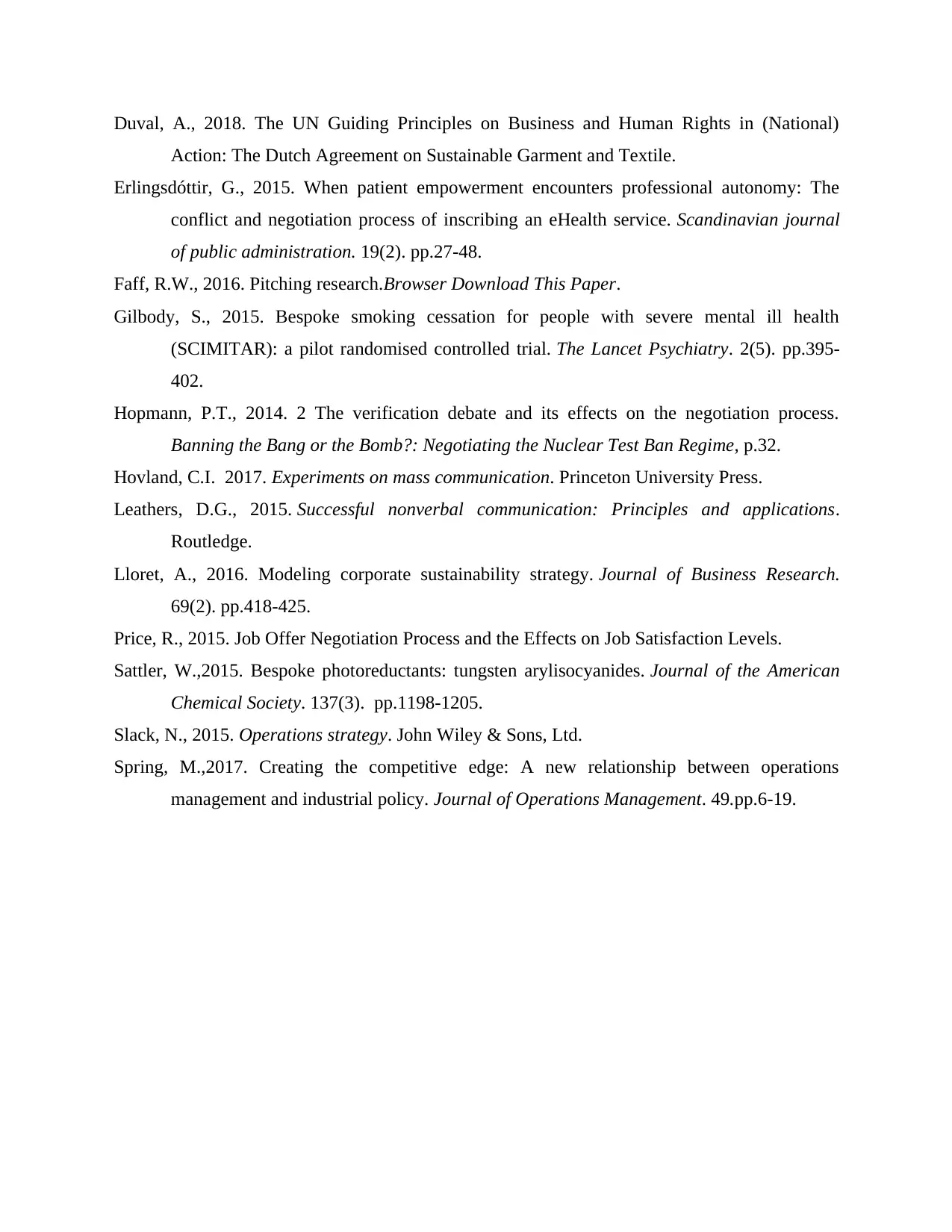
Duval, A., 2018. The UN Guiding Principles on Business and Human Rights in (National)
Action: The Dutch Agreement on Sustainable Garment and Textile.
Erlingsdóttir, G., 2015. When patient empowerment encounters professional autonomy: The
conflict and negotiation process of inscribing an eHealth service. Scandinavian journal
of public administration. 19(2). pp.27-48.
Faff, R.W., 2016. Pitching research.Browser Download This Paper.
Gilbody, S., 2015. Bespoke smoking cessation for people with severe mental ill health
(SCIMITAR): a pilot randomised controlled trial. The Lancet Psychiatry. 2(5). pp.395-
402.
Hopmann, P.T., 2014. 2 The verification debate and its effects on the negotiation process.
Banning the Bang or the Bomb?: Negotiating the Nuclear Test Ban Regime, p.32.
Hovland, C.I. 2017. Experiments on mass communication. Princeton University Press.
Leathers, D.G., 2015. Successful nonverbal communication: Principles and applications.
Routledge.
Lloret, A., 2016. Modeling corporate sustainability strategy. Journal of Business Research.
69(2). pp.418-425.
Price, R., 2015. Job Offer Negotiation Process and the Effects on Job Satisfaction Levels.
Sattler, W.,2015. Bespoke photoreductants: tungsten arylisocyanides. Journal of the American
Chemical Society. 137(3). pp.1198-1205.
Slack, N., 2015. Operations strategy. John Wiley & Sons, Ltd.
Spring, M.,2017. Creating the competitive edge: A new relationship between operations
management and industrial policy. Journal of Operations Management. 49.pp.6-19.
Action: The Dutch Agreement on Sustainable Garment and Textile.
Erlingsdóttir, G., 2015. When patient empowerment encounters professional autonomy: The
conflict and negotiation process of inscribing an eHealth service. Scandinavian journal
of public administration. 19(2). pp.27-48.
Faff, R.W., 2016. Pitching research.Browser Download This Paper.
Gilbody, S., 2015. Bespoke smoking cessation for people with severe mental ill health
(SCIMITAR): a pilot randomised controlled trial. The Lancet Psychiatry. 2(5). pp.395-
402.
Hopmann, P.T., 2014. 2 The verification debate and its effects on the negotiation process.
Banning the Bang or the Bomb?: Negotiating the Nuclear Test Ban Regime, p.32.
Hovland, C.I. 2017. Experiments on mass communication. Princeton University Press.
Leathers, D.G., 2015. Successful nonverbal communication: Principles and applications.
Routledge.
Lloret, A., 2016. Modeling corporate sustainability strategy. Journal of Business Research.
69(2). pp.418-425.
Price, R., 2015. Job Offer Negotiation Process and the Effects on Job Satisfaction Levels.
Sattler, W.,2015. Bespoke photoreductants: tungsten arylisocyanides. Journal of the American
Chemical Society. 137(3). pp.1198-1205.
Slack, N., 2015. Operations strategy. John Wiley & Sons, Ltd.
Spring, M.,2017. Creating the competitive edge: A new relationship between operations
management and industrial policy. Journal of Operations Management. 49.pp.6-19.
1 out of 11
Related Documents
Your All-in-One AI-Powered Toolkit for Academic Success.
+13062052269
info@desklib.com
Available 24*7 on WhatsApp / Email
![[object Object]](/_next/static/media/star-bottom.7253800d.svg)
Unlock your academic potential
Copyright © 2020–2025 A2Z Services. All Rights Reserved. Developed and managed by ZUCOL.





